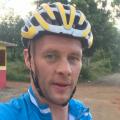
THERE can be a fine balance between managing a paralysed body and an athletes’ mindset.
I have a goal of riding the formidable Alpe d’Huez in France - but my body is struggling to keep up with the load of cycling endless climbs in Switzerland.
What I learned from Chris Hoy and Mark Beaumont was to ride smart, train smart and recover well.
Sometimes I don’t quite get this right - I tend to push my body a bit too hard in the pursuit of escaping paralysis.
As the damage from mistakes in my 2016 surgery take a even bigger toll on my spine, it makes navigating daily tasks like just getting my bike into the car after each ride a real challenge.
However as I was about to drive to France I read about this climb not far from the hotel.
“With almost fourteen kilometres of cobbled road that climbs over 800 meters and taken in 24 hairpins it reads as a cycling heaven.”
The St. Gothard Pass has featured in the Tour De Suisse close to forty times and is without doubt one of the best climbs in the world and should be on any cycling bucket list.
The road dates back to the 13th century, after the pass became a vital trade route between Northern and Southern Europe.
The beauty with this pass is there is now both a tunnel and a newer road, which leaves the cobblestone section pretty much car free.
In fact I only saw two cars on the entire ride.
Even though this is a must ride for any cyclist, after the first forty minutes I am struggling to keep my heart rate under 170 beats per minute.
I was wondering if taking on this beast after all the recent climbs was the wisest move.
Described as the greatest combination of cobbles and hairpins in the world, I kept telling myself this is a must do.
As the heat of the sun disappeared behind a cloud, the temperature starts to drop as I slowly grind up the cobbles.
With my back in pain I just focused on one hairpin at a time.
After what felt like hours another summit completed, another few hours of suffering on a climb that was rewarded with a very cold beautiful moment on top of what feels like a remote mountain in the middle of nowhere.
What I hadn’t really thought about was descending back down cobble stones paralysed and with a neck held together with metal cages and screws.
If coming up was hard work, going down was a nightmare.
The constant vibration ripped my carbon adapted leg out my cycling shoe and am sure the screws in my neck were thinking what is going on.
Finally back at my car in bits and back under the warmth of the Italian sun I had no idea how I was now going to drive to Alp D’Huez, however at this moment my only thought was how lucky I am to have a stable tumour, that has aloud me to come here and ride these roads.



Why are you making commenting on The Herald only available to subscribers?
It should have been a safe space for informed debate, somewhere for readers to discuss issues around the biggest stories of the day, but all too often the below the line comments on most websites have become bogged down by off-topic discussions and abuse.
heraldscotland.com is tackling this problem by allowing only subscribers to comment.
We are doing this to improve the experience for our loyal readers and we believe it will reduce the ability of trolls and troublemakers, who occasionally find their way onto our site, to abuse our journalists and readers. We also hope it will help the comments section fulfil its promise as a part of Scotland's conversation with itself.
We are lucky at The Herald. We are read by an informed, educated readership who can add their knowledge and insights to our stories.
That is invaluable.
We are making the subscriber-only change to support our valued readers, who tell us they don't want the site cluttered up with irrelevant comments, untruths and abuse.
In the past, the journalist’s job was to collect and distribute information to the audience. Technology means that readers can shape a discussion. We look forward to hearing from you on heraldscotland.com
Comments & Moderation
Readers’ comments: You are personally liable for the content of any comments you upload to this website, so please act responsibly. We do not pre-moderate or monitor readers’ comments appearing on our websites, but we do post-moderate in response to complaints we receive or otherwise when a potential problem comes to our attention. You can make a complaint by using the ‘report this post’ link . We may then apply our discretion under the user terms to amend or delete comments.
Post moderation is undertaken full-time 9am-6pm on weekdays, and on a part-time basis outwith those hours.
Read the rules here